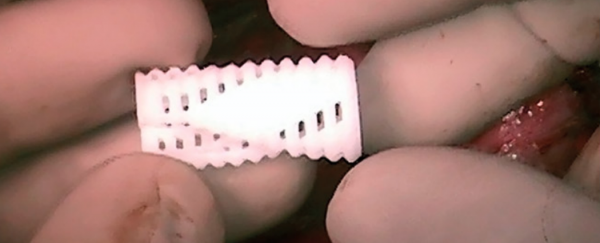Three babies affected by a rare disease that causes a person's central airways to collapse when they breathe have been saved through the use of a newly developed, 3D-printed splint.
Designed to prop open the airways to prevent any serious collapse, the splints will actually end up growing with the infants, and will eventually dissolve away once they've outgrown them. "This is the first 3D-printed implant specifically designed to change shape over time to allow for a child's growth before finally resorbing as the disease is cured," paediatrician Glenn Green from the University of Michigan in the US told the press.
Known to affect one in 2,000 children around the world, trachealbronchomalacia occurs when the cartilaginous structures that hold up the airway walls in the trachea and bronchi of the throat are weakened and damaged. This means that as a person breathes out, their central airways can soften and collapse, which can lead to life-threatening situations, particularly if the person is very young.
Often children who are born with the disease grow out of it in a few years as their central airways strengthen, but these three babies each had a severe case that, without effective treatment, would have killed them. "All had been in intensive care units for months and had episodes that required repeated resuscitations," Arielle Duhaime-Ross reports for The Verge. "In fact, the only reason these babies were allowed to participate in this study is because they were in such bad shape the airway splint was considered a therapy of last resort."
"One child was unable to have any food in his stomach due to his fragility," Green told her. He added that without the surgery, they would have only had mere days or weeks to live.
Using 3D scans of the babies' central airways as a guide, Green and his team 3D-printed tiny, custom-made splints using polycaprolactone (PCL) - a polyester material that can remain inside the body harmlessly for two to three years before it's broken down and absorbed. After testing them over and over on 3D models of the babies' airways, the team finally sutured them onto the real thing.
Reporting the process in Science Translational Medicine, the team says that not only have the implants successfully kept the babies' airways open, putting an end to the life-threatening situations that had kept them in intensive care all those months, but the baby who had had his implant installed three years ago appears to be cured. "This airway splint cured the children of an imminently lethal disease and now is dissolving," Green told The Verge.
The plan now is to print more of these life-saving devices - which only cost about $10 each to produce - and see if they can be used to treat other children affected by the disease. And what a story these three little patients will get to tell their own children one day.
Source: The Verge
